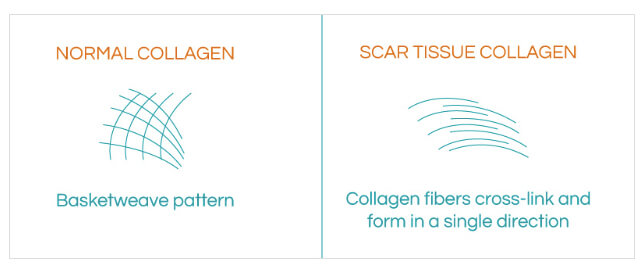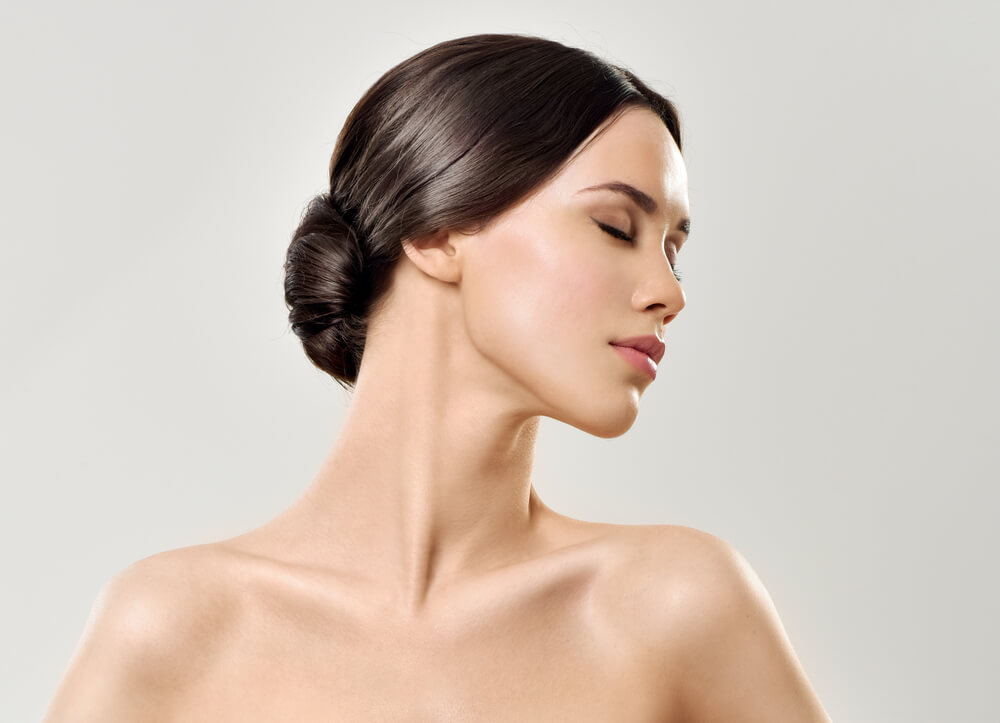
You’ve made it past your acneic days of juicy, pus-filled breakouts but you’re still haunted by the lingering marks…What gives? As if the acne wasn’t bad enough, now you have to work to reverse the aftermath. If you read our other blog this month, Types of Acne and What they Mean, then you learned all about the super fun possibilities that acne has to offer. In this post, we’re going to break down the various types of acne scars it can leave behind and, of course, how we can ditch them for good.
Before we dive in, we’re dropping some skin knowledge. Scar formation is a complex process, and, if we’re being real, it’s a process that isn’t even fully understood yet by scientists and researchers. That being said, the good news is, one of the main components in scar formation is collagen and as your Vancouver skin health experts, we know a thing or two (or 800) about collagen.
Collagen is the most abundant protein in the human body (it makes up around 30% of the body’s entire protein content!). It’s a building block that supports other tissues and structures throughout the body. Collagen isn’t just found in our skin, but also in our bones, cartilage, tendons, ligaments and many organs. Twenty-nine different types of collagen have been identified in the human body by scientists, however, types 1 through 5 account for about 90% of it, with type 1 being the most plentiful.
The Main Types of Acne Scars
Type I collagen is found in the skin, tendons, vascular ligature, organs and bone. Type I collagen is the main component of the organic part of bone.
Type II collagen is the main collagenous component of cartilage.
Type III collagen is commonly found alongside type I collagen in the reticular fibres.
Type IV collagen forms basal lamina, the epithelium-secreted layer of the basement membrane.
Type V collagen forms the cell surfaces, hair and placenta.
Type I and III collagen are the primary types of collagen that make up scar tissue. So, why do we get scars? Scarring is the body’s response to trauma and it’s part of the natural healing process. Wound healing is complex and involves four main phases: hemostasis, inflammation, proliferation and tissue remodeling. You can learn more by checking out our blog on healing scars and texture with micro needling. Collagen is mainly involved in the final two phases of wound healing, which is also when scar tissue can begin forming over the wound.
During the proliferation phase of wound healing, the cells surrounding the injury multiply rapidly. At the base of the wound, cells called fibroblasts work to produce new collagen in order to start the reconstruction of the skin’s extracellular matrix (ECM). As the wound then moves into the tissue remodeling phase, the collagen works its magic by controlling the tissue structure and restoring strength to damaged skin. But here’s what happens to the collagen of scar tissue: it cross-links and heads in a single direction instead of doing the nifty – and much studier – basketweave pattern that’s found in normal tissue.
 Generally, acne scars will fall into two categories: atrophic (“indented” or depressed scars – there’s a loss of tissue) and hypertrophic (“raised” – too much tissue is produced). Within these two categories, there are four subtypes of acne scars: ice pick, boxcar, rolling and keloid scars. Unfortunately, there are no topical treatments that can effectively raise sunken scars or breakdown raised scars, so it’s best to treat the scars early while they’re still red.
Generally, acne scars will fall into two categories: atrophic (“indented” or depressed scars – there’s a loss of tissue) and hypertrophic (“raised” – too much tissue is produced). Within these two categories, there are four subtypes of acne scars: ice pick, boxcar, rolling and keloid scars. Unfortunately, there are no topical treatments that can effectively raise sunken scars or breakdown raised scars, so it’s best to treat the scars early while they’re still red.
Atrophic scars
Simply put, atrophic scarring is a result of too little collagen production. There are three types of atrophic scars: ice pick, boxcar and rolling scars. Ice pick scars are deep, narrow and usually in the shape of a “v.” Boxcar scars have an opening on the surface that’s oval, round or wide. The opening leads into a hollow in the skin that’s in a box shape – it can be shallow or deep. Rolling scars are the widest atrophic scars and look like they’re rippled or layered. Much like we can have a combination of types of acne, we can also have a combination of types of acne scars.
ICE PICK: Ice pick scars are deep, very narrow scars that extend to the dermal layer and look as if someone stabbed the skin with an ice pick or other sharp object. Because of the small, deep hole, some ice pick scars have the appearance of a large, open pore. When a cyst or another inflamed blemish way down within the skin causes an infection that wanders up to the surface, skin tissue is destroyed in its path. This type of column-esque scar is what’s left behind.
BOXCAR: Boxcar scars are round or oval and the depression has steep vertical sides. When the skin looks pitted, you can thank boxcar scars, which are wider than ice pick scars. With inflammatory acne breakouts, collagen is destroyed and we lose skin tissue. Since the skin over the area doesn’t have support anymore, a depression forms. Depending on how much tissue is lost, the resulting boxcar scar can range from superficial to severe.
ROLLING: This type of scarring causes wavy, rolling depressions across otherwise healthy, normal looking skin. Rolling scars rear their heads when fibrous bands of tissue take up residence in the area between the skin and the subcutaneous tissue below. The bands then pull the epidermis, making it bind to deeper skin structures. As it pulls, it creates the rolling look.
Get that skin glowing in time for spring. Book a free consultation today
Hypertrophic scars
Ever heard the saying “too much of a good thing?” It’s a statement that proves to be true time and time again, especially in the case of collagen and scar formation. Hypertrophic and keloid scars are both a result of too much collagen production, however, they’re vastly different from one another.
Raised or hypertrophic scars are less common as a result of acne but may still occur due to ‘over-healing,’ which is when too much collagen is deposited during the healing process (the opposite of the loss of tissue that characterizes ice pick or boxcar scars). These scars are usually pink, thickened, raised lumps and, sometimes, they can be itchy or painful. We typically see hypertrophic scars from acne on the torso, especially in men. They often grow larger than the original wound. Steroid (cortisone) creams, silicone gels and injections may be used to help shrink and flatten scars.
Keloid scars, on the other hand, are uncommon and reddish-purple in color. Keloids develop as a result of an excessive healing process that is usually inherited. This type of scar can grow and can even become disfiguring. The biggest difference between a keloid scar and a regular hypertrophic scar is that a keloid will extend far beyond the original injury site and will continue to get increase in size if not treated.
Pigmented scars
While “pigmented scars” are not true scars, but rather post-inflammatory hyperpigmentation (PIH), they can be unsightly and difficult to treat, depending on your skin tone and the depth of the discoloration. Atrophic and hypertrophic scars come from the proliferation stage of healing, whereas pigmented stains or PIH come from the inflammation stage of the wound healing process. What happens?
Well, when your skin is open and exposed, like when you pop a pimple, it goes through the wound healing response and works to close the skin back up. Sometimes, this can leave abnormal pigmentation, texture and tone that looks different from the rest of the skin. Occasionally, the broken blood vessels from the micro-injury can even remain after the acne lesion has healed, resulting in a dark reddish/purple or brownish mark. To simplify this, think of it like a scab, but under the skin instead of on the surface.
PIH on its own can take anywhere from three to six months to go away without intervention, however, you can expedite this process with the diligent use of retinol, vitamin C and other brightening agents. It’s important to also consider the natural tone of your skin, as this can make a difference in the shade of PIH you are prone to. In lighter skin tones, red or purple marks are more common and usually fade over the course of a few weeks. For darker skin tones, the mark left behind will be on the purplish to brownish side and takes, on average, four months to go away on its own.
With acne stains, whether they are more red or brown, it is crucial to always wear sun protection (even on a cloudy day). The reason for this being, that while your skin is going through its healing response, it’s much more vulnerable and not as strong. In other words, the risk of damage caused by the sun is a whole lot higher and more likely. Imagine your pigmented lesion is a glob of something that fell on your clothing and then you iron over it. It just cooks into place. It’s gonna be much harder to get that stain out of your favourite shirt now than if you had soaked and spot treated it right away!
Treating and preventing scars
We all know that prevention is key but what if you already have the scar? Then what? Since it’s pretty difficult to determine what causes one person to scar more than another, the best way to avoid scarring is to treat acne with a comprehensive skin care routine and, most importantly: DO. NOT. PICK. Picking, poking or touching a pimple is a recipe for disaster. Every now and then, you’ll do everything right and still end up with a stain or a scar and that’s just because the damage had been done internally. What you do next is absolutely vital.
First, for treating atrophic or hypertrophic scars, you’re going to need to break down the overproduction of collagen or re-stimulate collagen production. We can do this easily with microneedling like we talked about in our post on treating acne scars with microneedling. The alternative treatment solutions include Fraxel laser or subcision. For PIH and acne stains, we have a number of options. While microneedling can work to break down hardened hemoglobin that causes reddish or brownish marks (great for combination scarring!), you can also treat these marks with laser, such as IPL, or even simply with products like retinol. For darker stains or darker skin types, hydroquinone might be needed to lighten and even out complexion overall, which we’ve covered before.
Still feeling lost and alone? Book a complimentary consultation with one of our Vancouver laser and skin care experts to learn the best treatment options for your scars.



